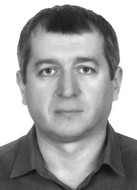Armwrestlers’ anthropometric analysis in different weight classes for success in national competitions
Фотографии:
ˑ:
PhD, Associate Professor A.V. Posokhov1
PhD, Associate Professor I.N. Nikulin1
PhD, Associate Professor L.A. Kadutskaya1
PhD V.A. Malakhov1
1Belgorod State National Research University, Belgorod
Objective of the study was to rate the armwrestlers’ anthropometric characteristics in different weight classes versus their success rates in national competitions. 58 armwrestlers qualified for the 2017 Russian student competitions were subject to the study. The anthropometric characteristics included body length and mass; chest circumference; wrist length; forearm length; strained shoulder circumference; strained forearm circumference; and hand-held dynamometry – for the reason that it is the upper limb physicality that is a key for success in this sport discipline. We applied an index method to analyze the anthropometric data arrays. The anthropometric data were obtained using the methods developed by the leading specialists in modern sport morphology. The study data and analyses showed the athletes with the longest (long shoulder) and shortest (long forearm) shoulder-to-forearm ratios having some advantage in this sport.
Keywords: arm wrestling, anthropometric characteristics, strength indicators, indices, success in competitions.
References
- Aleksanyants G.D. et al. Sportivnaya morfologiya. Ucheb. posobie dlya studentov vuzov, obuchayuschikhsya po napravleniyu 032100 i spetsialnosti, 032101, dop. Feder. agentstvom po fiz. kulture i sportu [Sports morphology. Textbook for university students majoring in 032100 and specialty 032101, ext. Feder. agency for nat. culture and sport]. Moscow: Sov. sport publ., 2005, 91 p.
- Volkova E. S., Salnikova E. P., Grebneva A. S. Morfologicheskie pokazateli studentov-sportsmenov razlichnykh spetsializatsiy [Morphological indicators of student-athletes of various specializations]. Uchenye zapiski SPbGMU im. akad. I. P. Pavlova, 2011, vol. 18, no. 2, pp. 42–44.
- Voronkov A.V., Nikulin I.N., Filatov M.S. Osobennosti razvitiya sily myshts-sgibateley kisti i paltsev v armsporte [Features of development of strength of hand and finger flexor muscles in armsport]. Kultura fizicheskaya i zdorovye, 2010, no. 4 (29), pp. 18-20.
- Zekrin A.F., Zekrin F.Kh., Zebzeev V.V. Antropometricheskie osobennosti dzyudoistov-yuniorov raznykh vesovykh grupp [Anthropometric characteristics of junior judokas of different weight categories]. Teoriya i praktika fiz. kultury, 2015, no. 4, pp. 11-13.
- Nikityuk D.B., et al. Antropometricheskiy status sportsmenov raznoy spetsializatsii i kvalifikatsii [Anthropometric status of athletes of different specializations and skill levels]. Uchenye zapiski SPbGMU im. akad. I.P. Pavlova, 2011, vol. 18, no. 2, pp. 98-99.
- Podrigalo L. V. Monitoring funktsionalnogo sostoyaniya sportsmenov v armsporte: mediko-biologicheskie i sportivno-pedagogicheskie aspekty [Monitoring of functional condition of armwrestlers: biomedical and sports-pedagogical aspects]. Kharkov: KhNMU publ., 2010, 149 p.
- Posokhov A.V., Nikulin I.N., Voronkov A.V. Analiz antropomorfologicheskikh osobennostey armrestlerov razlichnogo urovnya podgotovlennosti [Study of anthropomorphologic characteristics of armwrestlers with various fitness levels]. Mater. Vseros. nauch.-prakt. konf. s mezhdunar. uchastiem 'Razvitie fizicheskoy kultury i sporta v kontekste samorealizatsii cheloveka v sovremennykh sotsialno-ekonomicheskikh usloviyakh' [Proc. nat. res.-practical conf. with intern. participation 'Development of physical education and sports in the context of self-actualization of man in modern socio-economic environment']. Lipetsk: LSPU n.a. P.P. Semenov-Tyan-Shanskiy, 2017, pp. 279-282.
- Podrigalo L.V., Iermakov S.S., Jagie О.W. (2017). Special indices of body composition as a criterion ofsomatic development of martial arts practitioners. Arch Budo Sci Martal Art Extreme Sport; 13: 5-12.



 Журнал "THEORY AND PRACTICE
Журнал "THEORY AND PRACTICE